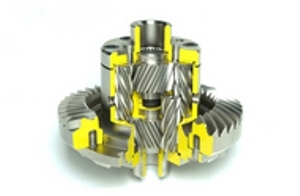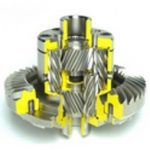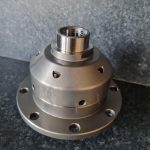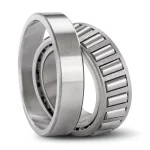Beschrijving
E46 316i, 316ti, 316Ci manual, 318i manual, 320i manual, 320i auto, 320i manual with 168 casing,
E81 118i manual
E82 120i auto
E87 116i manual, 118d manual with 168L final drive, 120d manual with 168L final drive, 120i auto with 168L final drive
E90 320i auto with 168L casing, 320i manual with 168L casing, 320si with 168L casing
BMW chose after the mid 90s outside of the ‘M’ cars to not fit an LSD, instead limiting the power by traction control, thus limiting the performance potential.
The ATB combined with BMW’s superb chassis and handling qualities allows the power to be efficiently handled, making the car faster, especially in slippery conditions.
Helical LSD Advantages:
- Equal rotational speed to both wheels
- Torque distributed according to traction
- Minimal service requirements – no clutches
- Quick reaction compared to viscous LSDs
- Gentle and progressive engagement, low noise
- Easily controlled power take-off and drifting
- Gears and body manufactured from 8620 alloy steel
- Direct replacement into stock differential
The helical LSD’s are torque biasing, that is they distribute torque between the wheels, loading more torque towards the wheel with the best traction thus improving performance and driveabitily. Especially in low grip situations.
The helical gearing manages the distribution of friction within the LSD. When torque is applied to the helical gear system it creates force that pushes the gear into the differential body, thus creating friction. Increases of torque, increases the thrust force directly proprotional to the amount of torque. This allows the LSD to cope with considerable traction imbalance even under heavy power conditions, as would be the case on exiting a powered up corner. But at low torque conditions the LSD can differentiate quietly and smoothly, thus making the differential very suitable for normal road driving. The LSD uses the popular parallel axis helical geared configuration optimised for even load distribution. They are designed with a torque bias of 5:1 this means that if one wheel loses traction then the wheel with the most grip can receive five times as much torque as the wheel that is slipping. However, five times zero is still zero, so all these helical LSD’s work best when both wheels are ‘planted’ and some traction is still available on the slipping wheel. In practice this is rarely a problem as there is always some ‘drag’ on the slipping wheel, however some drivers expertly use left foot braking to partially lock the spinning wheel.
Note – Helical LSD’s work especially well when combined with modern anti-lock braking systems.




